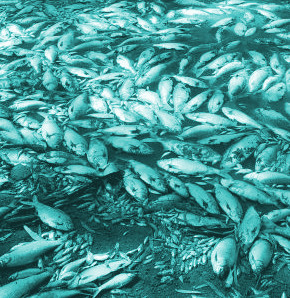Aerators arranged for sick river
 Water authorities are rushing to respond to mass death events in the Murray-Darling basin.
Water authorities are rushing to respond to mass death events in the Murray-Darling basin.
Up to a million Murray cod have died across a 40-kilometre stretch of river at Menindee, near Broken Hill, while another fish kill has occurred at Lake Hume.
Locals say the fish deaths have made what was already a substandard water supply now “absolutely disgusting”.
An emergency meeting was convened this week to discuss ways of managing the ongoing environmental crisis.
The Federal Department of Environment and Energy has blamed crippling drought conditions for sparking an algal bloom that is suffocating fish.
However, many consider the fish deaths to be a preventable catastrophe.
Australian National University professor John Williams has studied the health of the Murray-Darling Basin in detail and says too much water is being removed from the northern Basin.
“Any water management policy must be able to deal with the conditions we currently have, and clearly the policy is not doing that,” Professor Williams told the ABC.
“The Murray Darling Basin Plan (MDBP) has not removed water back to the environment in sufficient amounts to actually keep the river flowing so we avoid these conditions.”
He suggested irrigators reduce their take by about 40 per cent.
“Dead fish and dying rivers are not because of the drought, it’s because we are extracting too much water from our rivers as many of the large fish which are dying have lived for more than 50 years through many equally severe droughts,” Professor Williams said.
“Drought is part of the system and any plan must be able to manage our rivers through drought whilst maintaining ecological resilience of the rivers and floodplains.
“Clearly, the current MDB plan has failed to do that.
“This current tragedy was predicted and is no surprise.”
At this week’s response meeting, officials came up with a plan to pump oxygen into the river system and potentially relocate critical species to healthier habitats.
Four solar-powered aerators will be installed in the Lower Darling region, but NSW Regional Water Minister Niall Blair admits they are a “bandaid solution”.
“Nothing will stop this fish kill unless we get proper river flows and levels in our dams back to normal,” he said.
The devices will be placed at Lake Keepit near Tamworth and Lake Burrendong near Dubbo.
The water officials also discussed adding more water to the rivers, Murray-Darling Basin Authority chief executive Phillip Glyde said after the gathering.
They also considered relocating critical species of fish to healthier habitats, but issues such as biosecurity and fish stress would make it a particularly challenging option.
Federal Water Minister David Littleproud wants to take $5 million from existing Murray-Darling Basin funds to develop a strategy to look after native fish, but needs the agreement of all states to do so.
As for the ongoing ramifications, experts say that even if no more mass deaths occur, the effects will be felt for several years.
Much of the system’s native fish population comes from the Menindee Lakes and the lower Darling River, leading some to worry for the already endangered species of Murray cod and silver perch among the main casualties.







 Print
Print